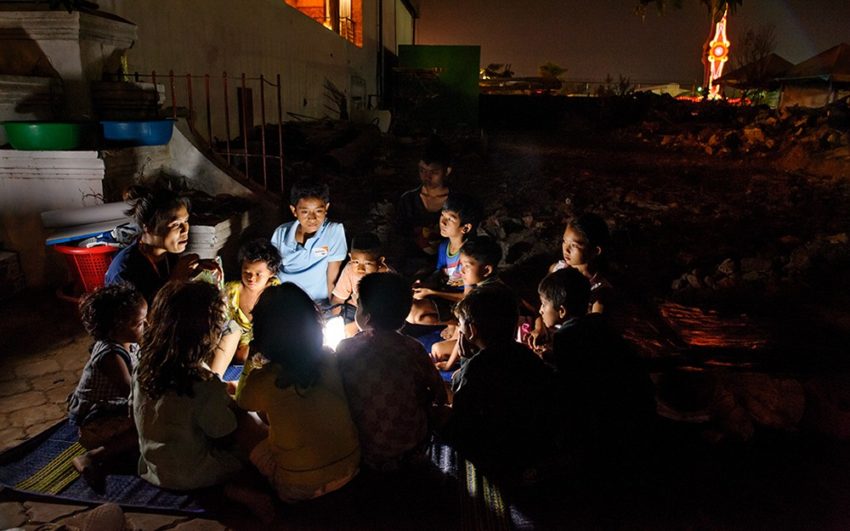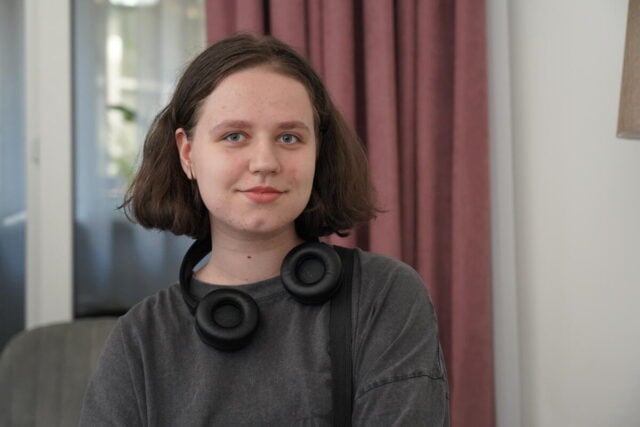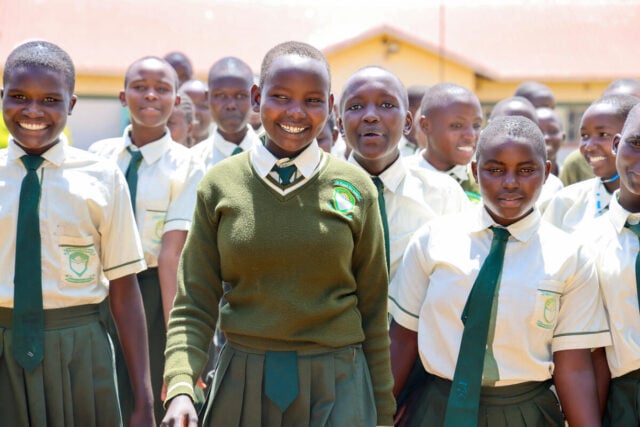For years I had the picture of a young boy who lived on the streets of Cambodia on the wall by my desk. When I first put it up, I didn’t even know his name, but I put his picture where I would see it every day to remind me to pray for him. As time went on and our lives became intertwined, it became a wonderful reminder of one of the first lessons I learned when I began working with World Vision: Look to the side of the road.
On a trip to Cambodia in early 2007, I had a God-ordained experience at a World Vision night outreach to children living on the streets of Phnom Penh. It was nearly 8:30 p.m. when six young staff members and I got in a pick-up truck loaded with food, water, medical supplies, and toys. We headed to the outreach site located by a garbage dump behind the city’s largest produce market.
As we drove by, I heard the excited cries of children as they recognized the truck’s World Vision logo. The staff comes twice a week, and it was obvious that their visits are a high point. Finding a square of open sidewalk, the truck stopped, thankfully up-wind from the odious dump. The staff jumped out and with well-practiced moves, set up the outdoor “kid’s camp.”
They set up a mini-medical clinic to one side and several children lined up to have minor cuts and infections treated. On the other side, a young woman sat down with colorfully illustrated books and was instantly surrounded by more than 30 eager children who listened to her explain about personal hygiene, brushing their teeth, and other health issues with the same rapt attention my grandchildren show when I read them a bedtime story. Then it was snack time, and afterward, the children played with toys, puzzles, and dolls.
A boy trapped by addiction
Far too soon it was time to pack up the toys and tarp and go on to our next stop, where I expected a similar scenario, with dozens of eager children flocking around the truck. However, only a handful of ragged boys came. For the most part, they were older, and their eyes had none of the child-like innocence I had seen before.
“These boys are all addicted to sniffing glue,” Vanthy explained, putting a name to what I was feeling. “Most of them have either run away from abusive families or been abandoned. They run in gangs in order to survive, but sniffing glue is the most important thing in their lives. You can see how thin they are. Most of them would rather sniff than eat.”
While the children at our first stop had been thin and obviously undernourished, these boys had the gaunt look of near starvation with skeletal arms and legs.
Their rough and tough exterior quickly fell away as they gathered around for storytelling. I was reminded of a scene out of Peter Pan when the Lost Boys gathered around Wendy, hungry for a story about mothers and home. Like those fictional man-boys, these “sniffers” were trapped in a Neverland of hunger, addiction, and hopelessness. Yet, despite their cocky air of independence, they were still at heart just children in need of love.
‘Lost boys’ of the street held hidden potential
I was startled out of my thoughts when one of the older boys suddenly stood up and began yelling at a boy who had been sitting quietly at the back, listening with the others. The brief tirade ended with a sharp slap to the boy’s head, causing the younger boy to scurry away from the group to watch from a safe distance.
Vanthy explained that the younger boy had been sniffing glue, and the older boy chased him away.
My heart went out to the little sniffer. I “looked to the side of the road” and saw that he had not gone far. He crouched at a safe distance, watching the others with a look of yearning. I was suddenly filled with compassion: How lonely it must be to be left out of even this small kindness!
I was suddenly filled with compassion: How lonely it must be to be left out of even this small kindness!—Marilee Pierce Dunker
Almost without thinking, I lifted my camera to capture his image, and he caught my movement. Instead of turning away as I would have expected, he smiled — a shy, friendly smile that lit up his face. It was like a light, revealing the intelligence and potential hidden behind the addiction and pain.
Surprised and encouraged, I asked Vanthy to talk with him. “Find out why he is here and if he would consider going to the center,” I asked.
Over the next few minutes, he answered her questions, telling a story of parental abuse and abandonment that was far too familiar. Later Vanthy gave me this detail.
“His father used to beat him and his mother regularly. Sometimes he was chained to a bed all day without food or water. When he was about 5 years old, the whole family moved to live in Phnom Penh. His father hit his mother and children very often and later left the family, marrying a young wife. After his father left, his mother became upset and stressful and started to beat the children without any reason. Because of this, he ran away from home.”
I asked why the boy doesn’t go to the center. “He has heard about the center from friends and knows he can find help there. But he is afraid to go because he knows he can’t sniff glue,” Vanthy explained after a few more minutes of conversation.
“But he is starving on the street,” I said, looking at his thin little body. “At least there he will eat.”
“He knows, and he will think about it. But he fears he won’t be able to stay without using the glue,” she said.
“Why? Why is the glue so important?” I asked.
The boy rubbed his tummy and looked at me with solemn eyes. “He says it takes away the hunger pains. If he has glue, he doesn’t need food,” said Vanthy.
“But without food, he will die.” My words seemed to hang in the air. There was no need for interpretation. The boy gave me one last resigned little smile, before walking away.
The work of God’s hand
As we rode back to the hotel that night, I could not get the image of that boy out of my mind. “I am going to print up his picture when I get home, and I will pray for him. Will you ask the staff to look for him and to keep encouraging him to go to the center?” I asked Vanthy. “I know God has his hand on that young life. We didn’t meet him by accident.”
“We will keep encouraging him,” Vanthy promised. “I’ll let you know what happens”
True to her word, Vanthy has emailed me several times since my return. Her emails tell an amazing story of God’s continuing faithfulness:
April 30, 2007
The child’s name is Rith. He is 13 years old. After your visit, Rith started to think about coming to the Bamboo Shoot Children Center. About a month later, when our outreach team was conducting a program near his place, Rith decided to come to our center. Unfortunately, he could not stay for long, due to missing glue and his friends in the street very much. So he went back to the street after a few days.
After receiving that bad news, I talked with our team to find out better ways to work more effectively with children like Rith. At last, Rith made the decision to come off the street and stay in the center again, along with some other children.
Rith says: “I live in the center to get my body free of drugs, have safe accommodation, have nutritious food and education, and receive healthcare. I am very proud that I have overcome glue addiction (no glue sniffing since then) and I thank God, as well as project staff, for helping me get out of it.”
I will take his photo and update you from time to time. —Vanthy
May 10, 2007
Today I visited Rith at the Bamboo Shoot Children Center. I hardly recognized him at first, but he remembered me well. He said that you and I were the ones who encouraged him to come to the center and to try stopping glue sniffing.
My heart beat rapidly with joy when I saw that he was stronger and healthier than before. The staff told me he has gained two kilograms (4.4 pounds) since he’s been at the center. I was very impressed with the way he speaks, looking straight at my eyes with confidence, and with his commitment to never go back to the glue sniffing. He said: “There is no benefit from sniffing the glue. It’s useless.”
He touched me deeply with his desire to help his mother. He said, “When I leave the center, I want to go back home to help my family. I feel very sorry for my mother who works very hard selling rice porridge every day. Nobody washes her clothes, as my big sisters are not with her anymore. I used to do this work for my mother when I was with her.”
Many children came to me and said, “Rith has given up the glue, he now works hard and is helpful to others.” One boy, who came to the center a little bit after Rith, mentioned to me that he and Rith were working together closely to give up the glue addiction, and they both are succeeding. It was fantastic to hear how Rith and the children at the center care about each other so much. —Vanthy
July 11, 2007
Rith is still with us in the center. We will keep him with us for about five or six more months. It will take that long to make sure he is healthy and has gained enough weight and that he will not go back to sniffing glue. We also want to make sure his mother will take him back and allow him to continue in school if he goes home.
We want to help Rith realize that he is worthy and valued. He is a good boy and can be very helpful in reaching other children like him. With this idea, we have started including Rith and a few other children in our outreach team. They have been going out two times per week to work with children living on the streets as per their routine activities. We observed that Rith was very happy and can do the job well! —Vanthy
____________
Epilogue
I now have two pictures on the wall by my desk. The first is of a nameless child in filthy blue rags. Unwanted, he is trapped in a world of addiction, without a future or a hope. The second is of a bright, healthy boy named Rith, who has discovered a whole new world of freedom and hope and who is helping other children to find it too. So I keep his pictures where I can see them every day to remind me to pray and to help me remember that there are treasures to be found by “the side of the road.”

Marilee Pierce Dunker travels the world as an ambassador for World Vision, the organization her father, Bob Pierce, founded in 1950. Like he did, she shares stories, pictures, and personal reflections, bearing witness to the extraordinary ways God is using his people to share the gospel and care for the poor.
Visit World Vision’s Speakers Bureau site to request Marilee or another World Vision speaker to present at your upcoming event.




